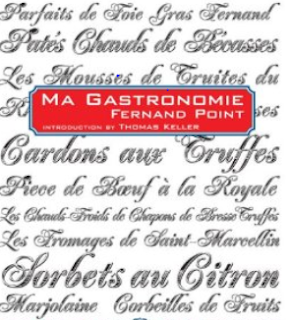Bluets,
Myrtels or Brimbelles.
The
native European bilberry is a small bluish-black berry similar to, but smaller
than, the American Bilberry and the blueberry.
www.flickr.com/photos/puntodevista/245219573/
The small European bilberries grow wild
in the foothills of the Vosges Mountains, in the old regions of Lorraine and Alsace
in the Grand
Est, in the department of Ardèche
in the Auvergne-Rhône-Alpes, and at the lower levels of many of France’s
mountainous areas. Wild bilberries will be on local menus between June and
August, unfortunately, they rarely reach the markets in the major
cities.
Vaccinium myrtilus, the European
Bilberry.
Photograph courtesy of BioDivLibrary.
The European bilberry grows on low bushes, in groups, and are easily picked. Despite their sweet but slightly acidic flavor, they are clearly a favorite in French regional cuisines. For chefs these berries flavor and color equally well.
Carré d'Agneau Rôti au Caramel de Bleuets - Roasted rack of lamb flavored with caramelized
bilberries.
Nems Croustillants à la Myrtille Sauvage, Glace Bulgare – Crispy spring rolls made with wild bilberries and served with Bulgarian ice-cream. From my experience, France’s Bulgarian ice-cream is locally produced Greek or Bulgarian yogurt made with added ice cream. However, never having been to Bulgaria I do not know how real Bulgarian ice-cream tastes.
Spring rolls came to France with the
Vietnamese with whom the French had a long and bloody relationship. In 18874/5
France had won a war with China, and in
1887 France created French Indo-China that included Vietnam. The French left
Vietnam in 1954 after their disastrous defeat at Dien Bien Phu. The French
leaving Vietnam led directly to America’s involvement that was followed by the
American Vietnam war.
It was Napoléon III who established
French Indo-China, that included much of today’s Vietnam. From this colony, many thousands of
Vietnamese came to France for government services, trade, school, and
university. Not all went home, and some
opened restaurants. On the menu listing above the spring rolls have been
adopted by a French or Vietnamese chef for a fusion dessert.
Suprême de Pigeon Cuit au Sautoir, Pulpe de
Charlotte, Jus
de Brimbelles Doux et Fort - Breast
and wing of pigeon cooked in a sautoir, a high-walled
frying pan and served with mashed charlotte potatoes. The accompanying juice
is a sweet and spicy bilberry sauce. In the Lorraine, wild bilberries
are generally called brimbles. (Including a description of the kitchenware
used in preparing a dish is part of French culinary tradition).
Tarte
Streusel aux Poires et Brimbelles – A pear and bilberry tart topped with sweet
buttery bread and or flour crumbs from the Lorraine region now including in the
super
region of the Grand Est.
Myro the aperitif of the Ardeche
In the department of Ardèche
in the Auvergne Rhône-Alpes for your apéritif, you will traditionally be
offered a Myro. A Myro is made with a
very cold Côtes du Rhône Rosé wine and a slight touch of Crème de Myrtille, a
bilberry liquor. A Myro is made
similarly to a Kir
which is a chilled white wine and Crème
de Cassis, a black currant liquor; France has quite a number of similar
aperitifs. At home, a Myro makes an
excellent apéritif when made with any good cold and semi-dry rosé. NB. Use only
a slight touch of Crème de Myrtille when making a Myro; that’s the voice of
experience!
European bilberries are rarely grown
commercially in France and in the
Lorraine they have chosen to grow the larger and sweeter American bilberries, and
there they are called the Bluets de Vosges. Given the choice I will choose the
smaller, wild, stronger tasting European family member.
If you wish to gather wild bilberries
while surrounded by breathtaking scenery, then the forests and mountains in the
Lorraine would be an enjoyable place to start. Consider making your base the
city of Épinal; it is the Prefecture, the capital, of the department of the
Vosges in the Lorraine region of the Grande Est. The Moselle river runs through
the center of the town, the forests and hills of the Vosges are next door. If berry picking is not enough exercise, then
40 km ( 25 miles) away is the town of Gérardmer; here every September they hold
Triathlon XL de Gerardmer. In Lac
Gérardmer, you swim for 1,900 meters, cycle for 90km (2kms and then run for 21 km ( 13 miles)
around the lake. Having completed the
course, you may then go out for dinner. (BTW the Lorraine is the home of the Quiche
Lorraine).
Bluets, Myrtels or Brimbelles - Bilberries in the languages of
France's neighbors:
(Catalan -
nabiu, avajó or mirtil), (Dutch - blauwe bosbes), (German -
bickbeere, heidelbeere, blaubeere, schwarzbeere), (Italian – mirtillo),
(Spanish - arándano, ráspano, mirtillo).
Bluets, Myrtels or Brimbelles - Bilberries in other languages:
(Chinese
(Mandarin) - yuè jú - 越桔), (Danish -
almindelig blåbær), (Filipino/Tagalog – duhat), (Greek –
mύρτιλο), ), (Hebrew - ochmanit shachora - אוכמנית שחורה), ( Korean - beullu
beli - 블루 베리), (Norwegian – blåbær), (Portuguese - mirtilo
eurasiano), (Rumanian – afinul), (Russian - -chernika - Черни́ка,
Черника обыкновенная), (Swedish – blåbär), (Turkish - yaban
mersini), (Ukrainian - Чорниця, або черниця, борівка). (Latin
- vaccinium myrtillus). Some translations come from Google Translate© and
some from Wikipaedia Copyright.
--------------------------------
Behind the French Menu
by
Bryan G. Newman
behindthefrenchmenu@gmail.com
Copyright 2010, 2013, 2018, 2019.
--------------------------------
Searching for the meaning of words, names or phrases
on
French menus?
Just add the word, words, or phrase that
you are searching for to the words "Behind the French Menu" (best
when including the inverted commas), and search with Google, Bing, or another
browser. Behind the French Menu’s links, include hundreds of words,
names, and phrases that are seen on French menus. There are over 450 articles
that include over 4,000 French dishes with English translations and
explanations.
















